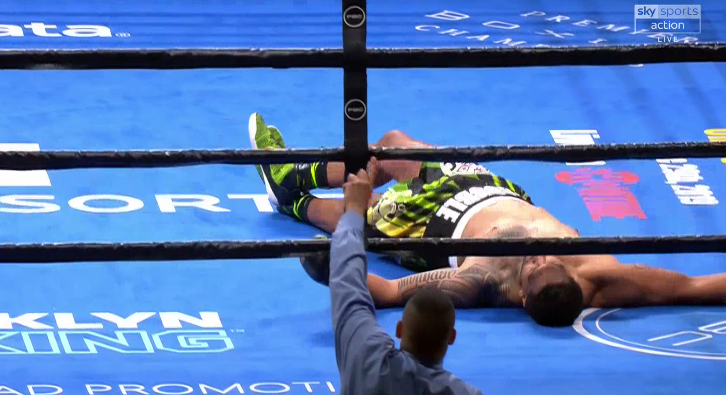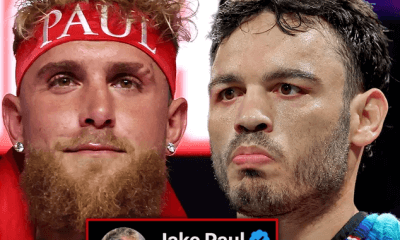Featured Articles
Fast Results from Brooklyn: Wilder Knocks Out Breazeale

Deontay Wilder vs. Dominic Breazeale figures to be entertaining for as long as it lasts said one pundit and he could not have been more prescient. Entertaining it was although if you were distracted you likely missed it. It was all over in 137 seconds
Wilder, making the ninth defense of his WBC world heavyweight title, stunned Breazeale with a big right hand early in the contest but then walked into a wild right hand by Breazeale and was himself momentarily stunned. He had enough presence of mind, however, to keep his cannon of a right hand unholstered and a few moments later he unleashed it again, leaving poor Breazeale flat on his back. Breazeale made it to his feet, seemingly as referee Harvey Dock reached the count of “10,” but he was in dire straits and the bout was waived it off.
This was the same Dominic Breazeale who lasted into the seventh round with Anthony Joshua not quite two years ago. As for Wilder, he remains undefeated with his 40th knockout in 42 pro starts and a match between him and Joshua or a rematch with Tyson Fury looms bigger than ever.
Co-Feature
WBC world featherweight champion Gary Russell Jr. successfully defended his title and completed the hat trick for the Russell Brothers with a fifth round stoppage of Spain’s Kiko Martinez. Russell (30-1, 18 KOs) was just too fast for the Spaniard and was on his way to a comfortable win on points when the fight was waived off at the suggestion of the ring physician because of a bad cut over Martinez’s left eye. A former IBF 122-pound champion, Martinez (37-9-2) is now 1-4 in world title fights.
Undercard
In the first of the TV fights, North Las Vegas junior welterweight Juan Heraldez remained unbeaten but barely as he was held to a draw by former IBF 130-pound world title-holder Argenis Mendez. One judge had it 97-73 for Mendez but the others had it even. Heraldez (16-0-1) was one of four Mayweather Promotions fighters on the card. Mendez, from Yonkers, New York, via the Dominican Republic, was held to a draw in a second straight fight, bringing his record to 25-5-3.
A previous draw ensued in an 8-round contest between 30-something heavyweights, Robert Alfonso (18-0-1) and Iago Kiladze (26-4-1). Alfonso, a Cuban defector and ex-Olympian who trains with Wilder in Tuscaloosa, weighed in at 254, giving him a 35-pound weight advantage. He had Kiladze fighting off his back foot for much of the contest, but the LA-based fighter from the Republic of Georgia snuck in enough punches to stem a 3-fight losing streak.
Bantamweight Gary Antonio Russell moved to 14-0 with a six-round technical decision over Tijuana’s Saul Hernandez (13-13-1). A clash of heads in the sixth round left the Mexican disoriented and the bout went to the cards where Antonio won by scores of 59-55 and 60-54 twice. Hernandez didn’t figure to go the distance. In his last three fights, he fattened up his record against opponents who were a combined 0-30.
In a fight slated for eight rounds, junior welterweight Gary Antuanne Russell improved to 9-0 (9) with a fourth round stoppage of Nicaragua’s Marcos Mojica (16-4-2) who had the misfortune of being thrust against a former Olympian in a second straight bout. Mojica was on the canvas twice before the referee intervened. He lasted longer than any of Russell’s previous opponents, none of whom lasted beyond three frames.
Brooklyn-born Richardson Hitchins, who represented Haiti in the 2016 Olympics, improved to 9-0 (5) when Columbia’s Alejandro Munero (4-2-3) was unable to answer the bell for round four. The 21-year-old Hitchins was making his eighth appearance at Barclays.
Dylan Price, a 20-year-old bantamweight from Sicklerville, NJ, improved to 8-0 when the corner of Mexico’s Manuel Manzo (4-7-2) stopped the one-sided beatdown midway through the sixth round.
Check out more boxing news on video at The Boxing Channel
To comment on this story in The Fight Forum CLICK HERE
-

 Featured Articles4 weeks ago
Featured Articles4 weeks agoAvila Perspective, Chap. 330: Matchroom in New York plus the Latest on Canelo-Crawford
-

 Featured Articles3 weeks ago
Featured Articles3 weeks agoVito Mielnicki Jr Whitewashes Kamil Gardzielik Before the Home Folks in Newark
-

 Featured Articles12 hours ago
Featured Articles12 hours agoResults and Recaps from New York Where Taylor Edged Serrano Once Again
-

 Featured Articles4 weeks ago
Featured Articles4 weeks agoCatching Up with Clay Moyle Who Talks About His Massive Collection of Boxing Books
-

 Featured Articles5 days ago
Featured Articles5 days agoFrom a Sympathetic Figure to a Pariah: The Travails of Julio Cesar Chavez Jr
-

 Featured Articles3 weeks ago
Featured Articles3 weeks agoMore Medals for Hawaii’s Patricio Family at the USA Boxing Summer Festival
-

 Featured Articles7 days ago
Featured Articles7 days agoCatterall vs Eubank Ends Prematurely; Catterall Wins a Technical Decision
-

 Featured Articles4 weeks ago
Featured Articles4 weeks agoRichardson Hitchins Batters and Stops George Kambosos at Madison Square Garden




















